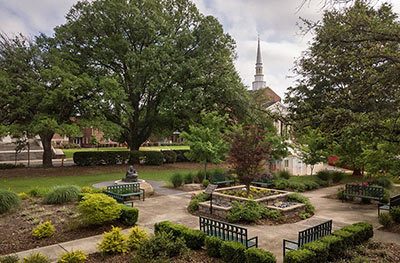Hurricane Katrina Book Brings Back Memories on Tenth Anniversary

Mississippi College’s family recalled the devastating impact of Hurricane Katrina ten years ago.
Former Gov. Haley Barbour’s new book “America’s Greatest Storm,” brought the nation’s worst natural disaster to life during his visit to the Clinton campus.
“It was an unbelievably gigantic, destructive hurricane,” Barbour said as he addressed hundreds of students at Tuesday’s chapel program.
Packing winds of up to 200 miles per hour, Katrina left 238 people dead in Mississippi and claimed the lives of 1,600 others in Louisiana.
While much of south Mississippi and other regions of the state were heavily damaged, Mississippians responded quickly. “People got knocked down flat, hitched up their britches and went to work,” said the former two-term Republican governor.
A little less than 18 months into his administration, Barbour faced the biggest challenge of his lifetime.
A total of 954,000 volunteers from around the nation poured in to help the Magnolia State recover. Many came from faith-based groups from a multitude of religious affiliations. “They felt it was their way to serve their God,” Barbour said as MC President Lee Royce and students gathered at First Baptist Church Clinton.
It was a massive recovery job. The federal government helped clean up 47 million cubic yards of debris.
Barbour’s book details the stories of how police, fire fighters, other first responders and ordinary neighbors stepped up at a critical time in the state’s history.
Scores of MC students lifted their hands when Vice President for Christian Development Eric Pratt asked if Katrina impacted their families.
“I had grandparents who evacuated Baton Rouge,” said MC sophomore Darby Damon, 19, of Madison. There was extensive water damage to their Louisiana home as well as power outages. “It was scary. I couldn’t get in touch with them.”
MC sophomore Hailey Williams of Hazlehurst was a ten-year-old girl when Katrina slammed into Mississippi. The electricity in her house in Copiah County was knocked out, so she and her family packed up and relocated to Arkansas on a temporary basis. “I went outside and there was dead silence. I knew the storm was coming.”
While the national new media focused on widespread destruction in New Orleans, “Mississippi bore the brunt of the storm,” Barbour said.
With Barbour’s office taking command with the assistance of other state and local leaders, Mississippi’s recovery proved effective.
Mississippi faced another powerful storm when Hurricane Camille pounded the state in 1969. “But it was nothing like Camille. Katrina had the greatest storm surge in the history of meteorology,” Barbour said in his October 27 speech. Katrina’s potent storm surge was reported to be 38 feet deep.
The powerful storm provides plenty of lessons for Americans when the next emergency occurs.
“In a mega-disaster, somebody’s got to be in charge,” said Barbour, a longtime GOP political leader and adviser.
His mother, the Yazoo City native said, always told him that “a crisis brings about the best in most people.”
His new book “America’s Greatest Storm” tells the story of how Mississippians rose to the occasion with a resilient spirit and the desire to help others.
After finishing his talk, Barbour signed copies of his book at a reception at the Leland Speed Library.
Mississippi College kinesiology professor Suzanne McDonough was among the admirers lining up at the library for his signature and the opportunity to thank him.
“Gov. Barbour has always demonstrated a great love for Mississippi and led the state with a masterful understanding of motivating people,” McDonough said. “His concern and commitment to Mississippi in times of crisis was key to coastal Mississippi having the tools to rebuild and flourish into the present day.”
Sign-up For Our Newsletter
Get the latest news about Mississippi College delivered right to your inbox by subscribing to the Along College Street e-newsletter.


